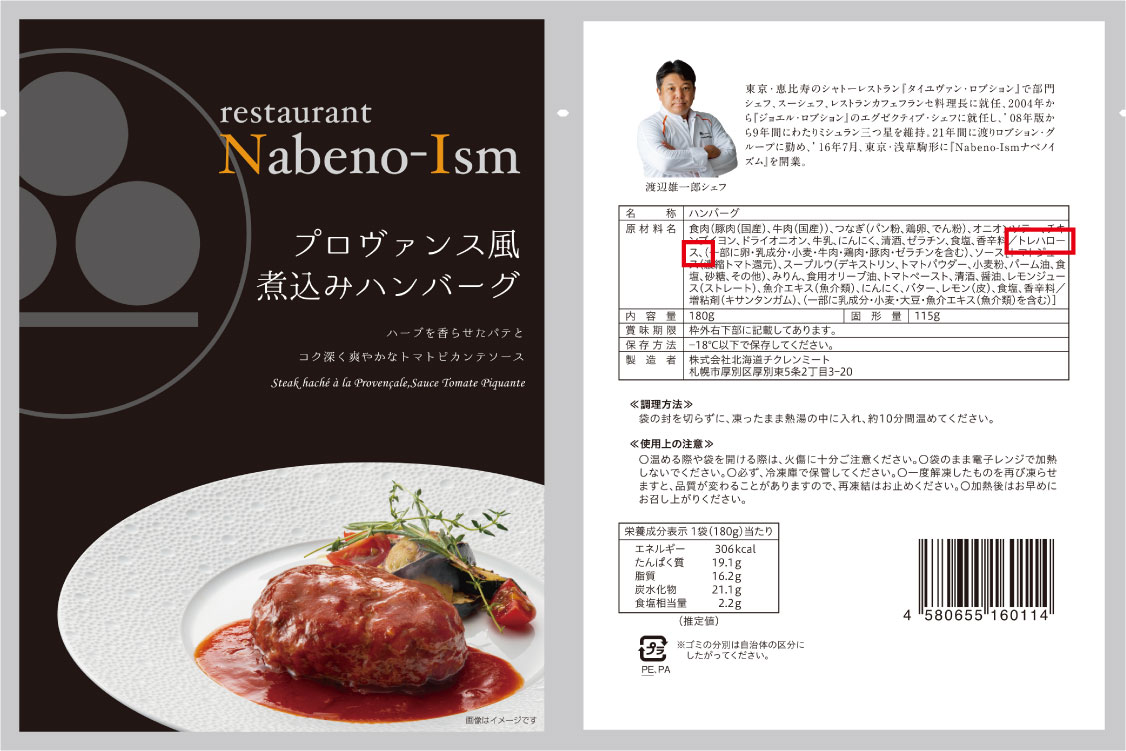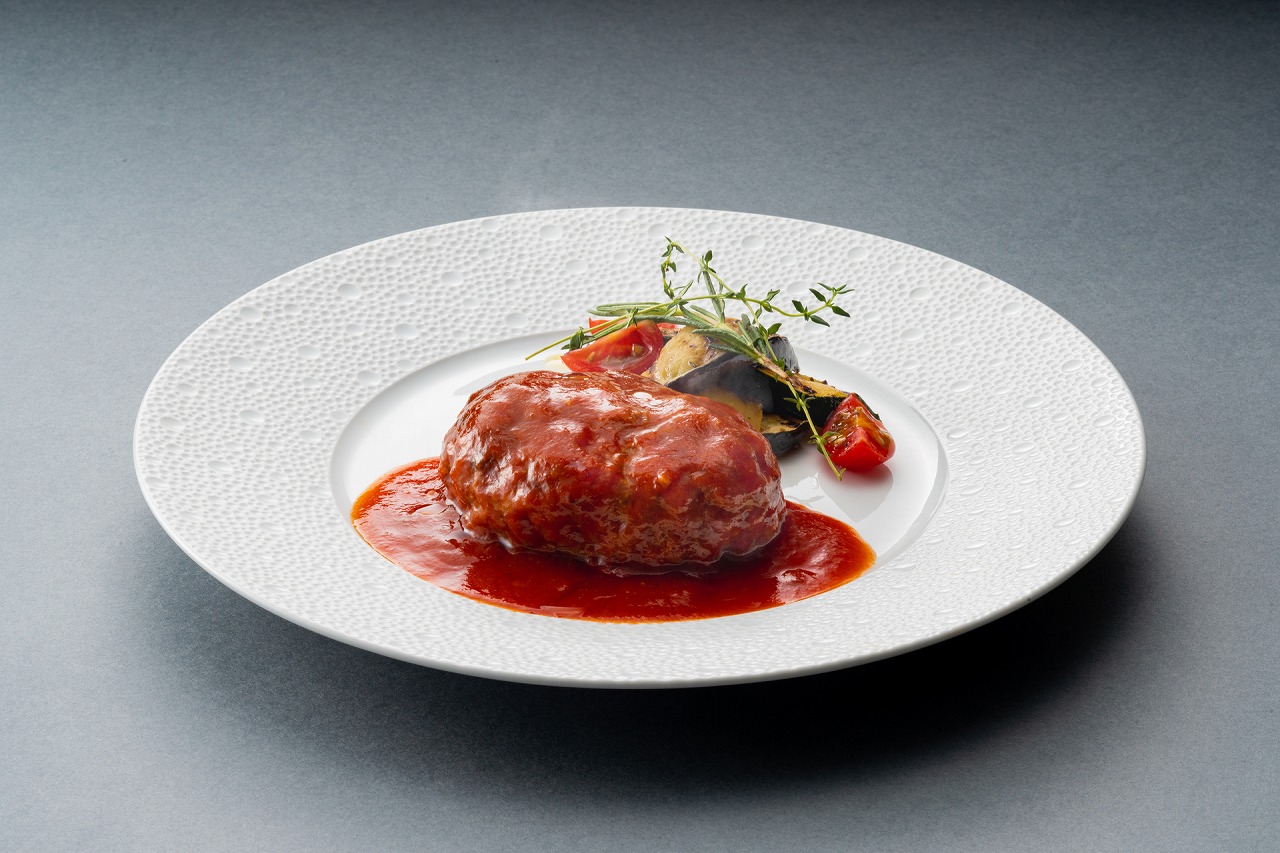News & Blogs
How Chef Watanabe found TREHA®
Chef Watanabe's favorite TREHA® benefits
Chef Watanabe explains his dishes: "Foie gras grilled by V.C.C. with coarse-ground coffee from Bach Café, ", Hokkaido rhubarb comport with framboise" and "Foamed rhubarb syrup and confiture with Ningyoyaki imbibered with SUZE liqueur--- traditional Japanese doll-shaped pancake from Kimuraya"
In this blog, we touch on diverse topics about Japanese food cultures, practices together with the culinary secret, TREHA®, and its important role in the Japanese food industry. We hope our blog helps you obtain in-depth knowledge of Japanese cuisine and the science behind it, which is hard to find elsewhere.
Today, we would like to present an interview with Chef Watanabe, one of the top Japanese chefs with an amazing career in French cuisine. He worked as an executive chef at Château Restaurant Joël Robuchon, Tokyo for more than 10 years and is currently the executive chef and CEO of Nabeno-Ism. The restaurant was rated "2 Stars" by Michelin Guide and "4 toques" by Gault & Millau. The interview took place on July 20th, 2019.
How did you know TREHA®? What made you start using it?
I learned about TREHA® from a TV advertisement. Whenever I come across a new product, I cannot help but taste-test and analyze it. I could have been the very first chef who started using TREHA® in the restaurant industry.
I tried TREHA® for the preparation of marinated salmon, in which I was using salt, pepper, and granulated sugar. I replaced half of the sugar with TREHA®. Then, I found that the salmon tasted cleaner without the fishy smell, and extra sweetness compared to that prepared with my standard method. Since then, I have been using TREHA® for various kinds of dishes while learning about its functionalities.
Which raw materials do you use TREHA® for? What are your favorite functions of TREHA®?
Salt, pepper, and TREHA® have been my staple seasonings for years. I see myself as an ultra-heavy user of TREHA®, which helps me bring out the best of ingredients and create a harmony among overall dishes. I use TREHA® for a variety of food materials with purposes:
For pre-treatment of fish in general, including salmon, to subdue the fishy smell
For pre-treatment of foie gras and charcuterie to subdue odors. TREHA® works especially well for foie gras. I also use TREHA® for all my charcuterie including terrine.
To keep seafood mousse smooth and fluffy after cooking. I have been frequently making seafood mousse since I was a young chef. I wanted to improve the dry texture for a long time. Thanks to TREHA®, I was able to achieve that goal. TREHA® also increases the viscosity of pre-cooked mousse, which results in the ideal consistency in a finished product.
For processing fruits (compotes, confiture, sauces) to maintain natural and clean color with increased gloss.
For cooking leafy green vegetables including spinach to bring out and maintain their natural, appetizing colors.
For cooking any type of beans to make them soft and fluffy without falling apart.
I can confidently say that I am now using TREHA® for all of my course menu because I use TREHA® for foie gras, which is a mainstay of my course menu.
Do you take advantage of TREHA® for extending shelf-life or improving freeze-thaw stability?
It is standard practice for a smaller scale restaurant like my own to use up all ingredients within a day while they are fresh. Therefore, I don’t think about extending the shelf-life of ingredients by using TREHA®, but the important thing is to maintain the best conditions of prepared ingredients, for example, vivid colors of produce and stabilized foams in creams, sauces, and bakery applications.
Would you explain your creations, "Foie gras grilled by V.C.C. with coarse-ground coffee from Bach Café", "Hokkaido rhubarb compote with framboise", "Foamed rhubarb syrup and confiture with Ningyoyaki imbibered with SUZE liqueur", please?

Foie gras is regarded as one of the world’s top delicacies that French techniques can serve well. As it is my favorite ingredient, I never fail to use foie gras in my menu. I would use it with sweet fruits, which is a textbook application. Meanwhile, I combine it with flour dough, which is a classic French technique. Redefining traditions while utilizing classic techniques is my cooking style.
Part of redefining tradition involves integrating products from long-standing establishments into my dishes. Kimuraya and Café Bach are friendly neighbors in the Asakusa area, where my restaurant is. Kimuraya has been in business for 150 years, making Ningyoyaki (Japanese-style doll-shaped pancake). Café Bach also has a long history, serving flavorful coffee for local people. I created two dishes in homage to their products. For Ningyoyaki, I accommodate seasonal favor for infused syrup. For the foie gras dish, I use Café Bach's coarse-ground coffee just like pepper sprinkle. The bitterness harmoniously integrates the umami of foie gras and the sweetness of rhubarb.
Foie gras
TREHA® reduces odors specific to foie gras. Before I learned about it, I was using sugar to deal with the odors for a long time. Some people would opt for honey or maple syrup to do the same. Although sugar and other materials do their job, I was unhappy with the extra sweetness caused by this method. It was TREHA® that finally solved this issue. Although the intensity of the odors varies by the freshness of foie gras, TREHA® guarantees a finished product with consistent quality.

Ningyoyaki (Japanese-style doll-shaped pancake)
TREHA® makes syrup stay in the pancakes, making them moist and flavorful.
Rhubarb compote
TREHA® keeps the vivid color of rhubarb over an extended time. Rhubarbs tend to break into pieces during cooking, but when cooked with TREHA®, they become soft, maintaining their shape and clean edges. Extra sweetness is not required for the compote since it is served with main dishes, not with desserts. I can make mildly sweetened compote by using TREHA® with low sweetness whereas rhubarbs taste dull and cloying when prepared using only sugar.

Foamed rhubarb syrup with a flavor of mint and lemon verbena
TREHA® improves the stability of the foamed syrup prepared by a hand blender and makes the foams finer and smoother. TREHA® increases the viscosity of the syrup, which makes lecithin more potent
Fall 2021: New dining style introduced by Chef Watanabe's "Nabeno-Ism"
If you live in Japan, we have good news for you. While it is difficult to visit his restaurant due to the pandemic, you can still enjoy the restaurant's taste, "Provence-style stewed hamburger steak" at home. This frozen meal is developed by Chef Watanabe, reserving the best quality and is available for home delivery.

Chef Watanabe explains in his restaurant website, "This is a popular national dish called 'Steak haché' in France. When I lived in France, I enjoyed this hamburger steak with mustard or tomato ketchup just like French people. I develop the sauce as a tribute to the taste of Southern France, which is immensely tied to my nostalgia.
We share a secret with you. Trehalose (product name: TREHA®) is used in this special hamburger steak that represents Chef Watanabe's memoirs from Southern France. The steak can be distributed frozen without losing its quality thanks to the freeze-thaw stability TREHA® provided. This successful development proves that TREHA® could play an important role to reduce food loss and food waste by improving freezing techniques without needing industrial equipment. We are proud that TREHA® not only solves culinary challenges but also contributes to the Sustainable Development Goals (SDGs).

Did you find this blog interesting?
Please share it with your friends in the food service industry.
We regularly update the blog about the food culture of Japan, where TREHA® was discovered for culinary applications.
Click here and send us a message to subscribe.
Or hit us up on Instagram @trehalose_sensei!

